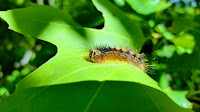Chris McGann
Communications
 |
Eighth grader, Addie Barker calibrates a class F metric weight
set used by WSDA Weights and Measures inspectors. |
The white cotton glove on Addie Barker’s left hand gave her the look of a museum curator or gemologist. With a steady hand, the 14-year-old gripped a tiny metal weight with a large tweezer and placed it gingerly on the digital scale next to her laptop.
State Metrologist Leslie German watched attentively, guiding her through each step and adding occasional pointers.
Anything from the room’s temperature or humidity to the manner in which Addie sets the weight on the scale could influence the reading.
The eighth grader from NOVA Middle School had ventured beyond the confines of her Olympia classroom to WSDA’s Metrology Laboratory last week as part of the school’s “World of Work” project. She was there to experience a slice of the work life she might expect if she pursues a science-based career.
 |
State Metrologist Leslie German shows Addie Barker how to log data from a
calibration. |
This job shadow is an example of the many opportunities the agriculture industry holds for young people exploring career options – some of which may not be the first to come to mind when thinking of agriculture.
Though farming and ranching are cornerstones and what most people think of first at the mention of agriculture, some might not realize how fundamental science is to the entire agriculture industry.
As such, work in agriculture offers myriad job opportunities for aspiring scientists – careers in chemistry, microbiology, genetics, process management and ecology to name just a few.
The little-known, analytical world of metrology, or the science of measurement and measurement uncertainties, is another example.

It is the heart and soul of WDSA’s Weights and Measures Program, which tests and inspects commercial devices to provide price verification and equity for commercial transactions. The program is responsible for package inspection, public education, fuel quality monitoring, and complaint investigations.
The state Metrology Laboratory provides the verified standards and analysis for Weights and Measures field inspectors.
Without an accurate reference for a gallon or a gram or a metric ton, there would be no way to assure the public and private companies that they are getting what they’re paying for at gas pumps, grocery scales or highway weight stations.
 |
| A standard used to calibrate an official scale. |
Metrology, a field that is, in a very literal sense, defined by precision, the hard sciences such as mathematics, statistics and physics are paramount.
Addie says she’s just “OK” at math, but when pressed she admitted that she currently carries a 98 percent average in her algebra class.
German, a former educator, said it was encouraging to see a young woman like Addie going into science.
“She really does have interest and I’m really tickled about that,” German said.
If Addie is really inspired by metrology, employment opportunities are plentiful.
 |
| Weighing the standards is more complicated than you might think. |
“Oh my gosh! there are so many, there are labs at Boeing, medical research laboratories, it’s all over the state,” German said. “You don’t realize it, there are labs everywhere. Every state has at least one lab and a lot of biotech companies have metrologists on staff.”
German is the first woman to hold the position of Washington’s State Metrologist and industry-wide she says women are under-represented.
Although Addie clearly has the mathematical aptitude to pursue a career in metrology, she said parts of the discipline are a bit intimidating.

“I don’t think I’m organized enough to be able to do it,” she said.
But in the precise environment of the laboratory, the soft-spoken teen’s precision and a keen attention to detail shined through as she carefully recorded each observation on a spread sheet and replaced the standard to the rack.
From this observer’s prospective, it seems likely her organizational skills were more than adequate to allow her to pursue metrology or almost any scientific career path if she chooses.
She’ll probably pass her algebra class, too.
















